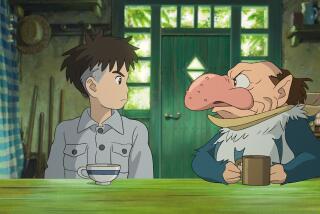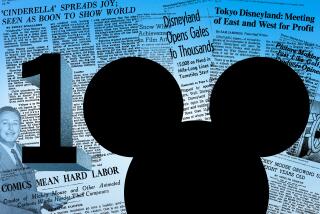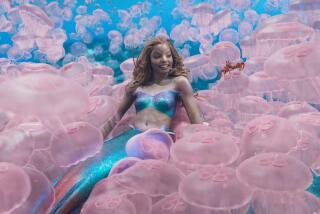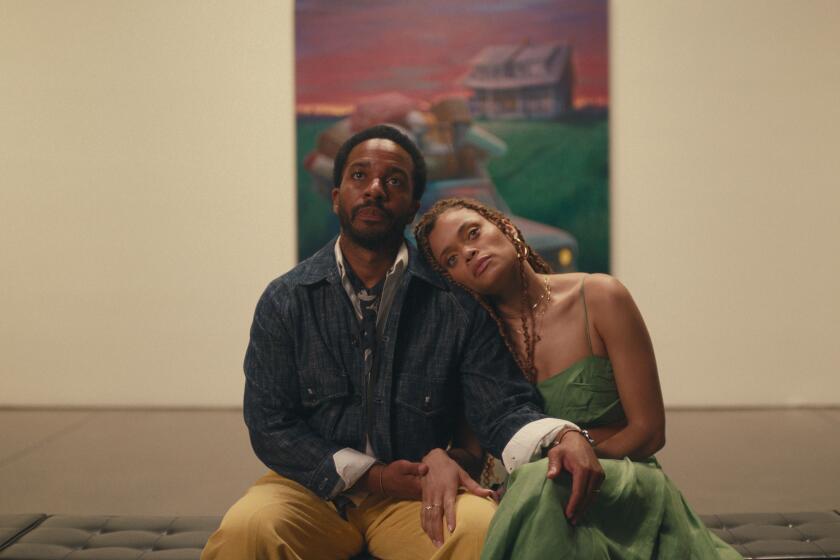Disney dusts off ‘Sleeping Beauty’
Among the latest batch of old films making their DVD premieres is one of the Disney studio’s animated classics, “Sleeping Beauty.” And just in case you’ve already purchased it on videotape, this edition comes laden with extra features.
Produced in 1959 for the then-staggering cost of $6 million, “Sleeping Beauty” ($30) is one of the most unusual of all the animated films that were made during Walt Disney’s lifetime.
Disney had issued an edict that he wanted the film -- which was shot in a wide-screen process known as Technirama and recorded in stereo -- to resemble a moving illustration. He gave the task of designing the look to artist Eyvind Earle, who had come to work at the studio in the early ‘50s.
Credited as color stylist, Earle gave the production its distinctive look, designing the linear, panoramic and very detailed backgrounds and applying a bluish-greenish color scheme. The character animators then had to work within Earle’s vision.
Set to Tchaikovsky music for the ballet version of “Sleeping Beauty,” the fairy tale revolves around Princess Aurora, who as a baby is cursed by the evil Maleficent to prick her finger on a spinning wheel by the age of 16 and die. Aurora’s fairy godmothers can’t reverse the entire curse, but they do alter it: If she does prick her finger, she’ll fall into a deep sleep but will awaken if she is kissed by her own true love.
Raised in seclusion by the fairies -- Flora, Fauna and Merryweather -- Aurora falls victim to the curse. It falls to dashing Prince Phillip to battle Maleficent, in the form of a gargantuan, fire-breathing dragon, in hopes of delivering the awakening kiss.
Despite the exquisite look of the film and the enjoyable characters, “Sleeping Beauty” doesn’t tug at the heartstrings like Disney’s “Bambi” or “Dumbo.” And it isn’t necessarily for young children: They may be frightened by the machinations of Maleficent, especially when she transforms herself into the dragon.
The “Sleeping Beauty” two-disc set is a lavish affair with extras geared for children and adults.
For youngsters there is the “Rescue Princess Aurora” game and the “Princess Personality” game.
For older animation buffs, there’s a comprehensive documentary on the film’s production, a story outline of the studio’s first attempt at making the film in 1951, an exploration of the film’s score (with the voice of Aurora, renowned opera singer Mary Costa), and a look at the film’s unique design featuring Earle, film historian Leonard Maltin and veteran Disney animator Ollie Johnston.
There’s also fascinating live-action footage of dancer Helene Stanley that the animators used to create reference poses of Aurora, as well as photographs of live-action sequences used for Prince Phillip’s fight with the dragon.
Also included are an exhaustive virtual gallery of concept art of Aurora, Maleficent, the fairies, the royal household and miscellaneous characters; a layout and background gallery; three trailers and even the Oscar-winning short, “Grand Canyon,” which accompanied “Sleeping Beauty” when it was first released.
The film is featured in both wide-screen and full-screen versions -- there’s even an explanation of the two formats -- and has been beautifully restored digitally, frame-by-frame.
The informative audio commentary, however -- which includes Costa, Earle and Johnston -- is only available on the wide-screen version.
More to Read
Only good movies
Get the Indie Focus newsletter, Mark Olsen's weekly guide to the world of cinema.
You may occasionally receive promotional content from the Los Angeles Times.









